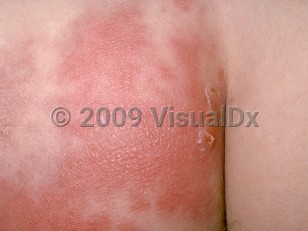Erysipelas in Infant/Neonate
See also in: Cellulitis DDx,AnogenitalAlerts and Notices
Important News & Links
Synopsis

Erysipelas is a superficial bacterial infection of the skin most often caused by beta-hemolytic group A streptococci (Streptococcus pyogenes). It involves the lymphatics of the superficial dermis. Erysipelas usually occurs in isolation and has a predilection for the extremes of age, debilitated patients, and patients with poor lymphatic drainage. Erysipelas can occur on the face but is more commonly seen on the lower extremities of adults with venous insufficiency and stasis dermatitis. In children, the scalp, face, and hands are the most common sites of involvement, although it may occur anywhere. Neonates present more commonly with rapidly spreading periumbilical erythema.
Clinically, the infection presents as a strikingly red, well-demarcated plaque that is very tender. Burning paresthesias may be present. Cutaneous findings are usually preceded by abrupt onset of fever, chills, nausea, and malaise. In neonates and infants, poor feeding, irritability, and lethargy may accompany erysipelas. Lymphadenopathy is almost always present.
Trauma to the skin is thought to be an important factor in the development of erysipelas; therefore, a concomitant dermatophyte infection, surgical incision, ulceration, insect bite, or inflammatory skin condition may provide a portal of entry for bacteria. The nasopharynx is often the reservoir in cases of facial erysipelas. Additional predisposing factors for erysipelas include diabetes, immunocompromised states, and nephrotic syndrome.
Penile erysipelas responds to treatment with antibiotics but tends to recur, causing a progressive, chronic lymphedema with permanent swelling of the penis (elephantiasis). Elephantiasis may also develop in the lower extremities from recurring bouts of erysipelas.
If not treated promptly, complications in children include meningitis, septicemia, endocarditis, toxic shock, and necrotizing fasciitis.
Clinically, the infection presents as a strikingly red, well-demarcated plaque that is very tender. Burning paresthesias may be present. Cutaneous findings are usually preceded by abrupt onset of fever, chills, nausea, and malaise. In neonates and infants, poor feeding, irritability, and lethargy may accompany erysipelas. Lymphadenopathy is almost always present.
Trauma to the skin is thought to be an important factor in the development of erysipelas; therefore, a concomitant dermatophyte infection, surgical incision, ulceration, insect bite, or inflammatory skin condition may provide a portal of entry for bacteria. The nasopharynx is often the reservoir in cases of facial erysipelas. Additional predisposing factors for erysipelas include diabetes, immunocompromised states, and nephrotic syndrome.
Penile erysipelas responds to treatment with antibiotics but tends to recur, causing a progressive, chronic lymphedema with permanent swelling of the penis (elephantiasis). Elephantiasis may also develop in the lower extremities from recurring bouts of erysipelas.
If not treated promptly, complications in children include meningitis, septicemia, endocarditis, toxic shock, and necrotizing fasciitis.
Codes
ICD10CM:
A46 – Erysipelas
SNOMEDCT:
44653001 – Erysipelas
A46 – Erysipelas
SNOMEDCT:
44653001 – Erysipelas
Look For
Subscription Required
Diagnostic Pearls
Subscription Required
Differential Diagnosis & Pitfalls

To perform a comparison, select diagnoses from the classic differential
Subscription Required
Best Tests
Subscription Required
Management Pearls
Subscription Required
Therapy
Subscription Required
References
Subscription Required
Last Reviewed:11/12/2020
Last Updated:11/12/2020
Last Updated:11/12/2020
 Patient Information for Erysipelas in Infant/Neonate
Patient Information for Erysipelas in Infant/Neonate
Premium Feature
VisualDx Patient Handouts
Available in the Elite package
- Improve treatment compliance
- Reduce after-hours questions
- Increase patient engagement and satisfaction
- Written in clear, easy-to-understand language. No confusing jargon.
- Available in English and Spanish
- Print out or email directly to your patient
Upgrade Today

Erysipelas in Infant/Neonate
See also in: Cellulitis DDx,Anogenital

